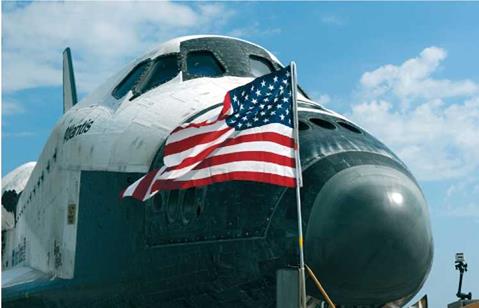2011-PRESENT: UTILIZING THE RESOURCES
In 2011, the 50th anniversary of manned space flight was celebrated. With it came the retirement of Shuttle and the transition of ISS from a construction site to a fully operational science research facility. It is too early to fully analyze what lessons have been learned from this decade as we are not yet a third of the way through it, but based on operations on the station during the previous decade, the difficulties of managing time on the facility remain. Even with a six person crew and full experiment facilities attached, there is still too much time spent in maintenance, repair and cleaning. Locating items and keeping track of the inventory only works, even with the help of a barcoding recording system, if the data is input correctly. This was a lesson learned back in the days of Skylab, but has it
|
The end of an era—Space Shuttle Atlantis on the ground at the end of the final Shuttle mission STS-135 July 2011. |
fully translated to today’s space station? Exercise and fitness programs in preparation for the return home also impact on crew time for science and research, and anything new can disrupt even the most trained and prepared crew. Visiting crews can be a welcome relief to the daily routine on station, but they also impede the natural flow of the main crew built up over time and it takes a while for a new crew to get up to speed.
Between the return of the American Skylab 4 astronauts in February 1974 and astronaut Norman Thagard launching to Mir in March 1995, the flow of experience of space station operations was lost by the Americans and the skills had to be learned all over again. Thagard commented, after coming home from a challenging mission in July 1995: “As we move into the era of long duration space flights, we need to consider that the problem of conducting complex experiments with little training is unavoidable.” Thagard went on to explain that if a mission is long in duration, the first sessions of some experiments may not be conducted for some months after last training on them and if these experiments were in early development or preparation, the crews may not have even trained on them at all. This was first recognized by the Skylab astronauts and had long been known by the Soviets. It could be a new challenge as crews move out from Earth and do not conduct the experiments they trained for until some months after their mission began.
As the sixth decade continues, new lessons will be learned, continuing to expand the skills and knowledge of the first fifty years. These lessons can hopefully be applied not only to future ISS and Tiangong expeditions, but also to follow-on programs which take us deeper into space. Despite over 50 years of human exploration of space we have still only taken a few steps in the trail first pioneered by Gagarin. With each new space flight a further step forward is taken, but these missions are destined for future entries in the log book of manned space flight.
|
|











